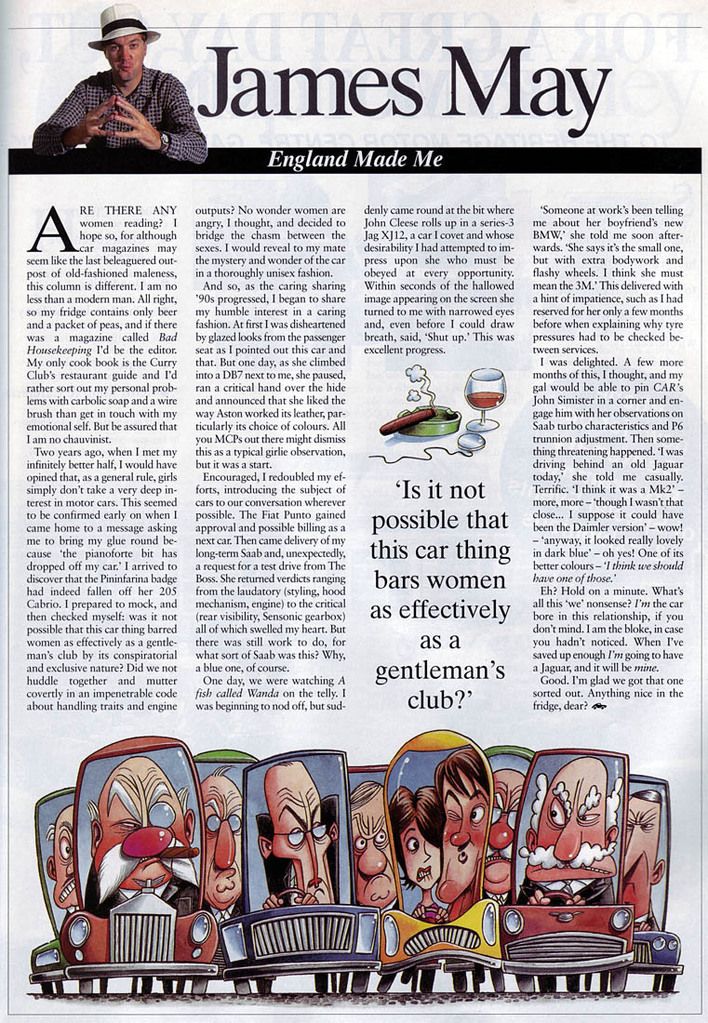|
|
Post by RedMoon11 on Aug 7, 2014 4:24:14 GMT
Car Magazine March 1996  |
|
|
|
Post by RedMoon11 on Jun 15, 2016 9:55:08 GMT
 James May on downsizing and the future of motoring James May on downsizing and the future of motoring: CAR+ archive, February 1998
Published: 14 June 2016  ► Our most famous former columnist ► Our most famous former columnist
► James May on the future of the small car
Will the small car be the saviour of motoring? May has fresh new evidenceLess, as the hackneyed saying goes, is more. Then again, it seems fashionable at the moment for writers to twist and convolute a whole article so that they can end by announcing smugly that less, is indeed, less. So what is less? For the past few months, I have been endeavouring to answer this question with particular reference to the small motor car. Let’s have a look at the apparatus for this experiment, the 1/24th-scale Seat Arosa 1.4 automatic I have been running since August. Up until then I had been tooling around in the sort of machines with which the Arosa might well come as a free gift – Saab, Alfa Romeo, Land Rover and so on – and was very interested to gauge the psychological effects of what people with less money than they used to have like to call ‘downsizing’. More importantly, I was keen to establish if there was any credibility in the widely perpetuated notion that, although the motor car is teetering towards the status of the century’s number one public enemy after Hitler, everything will be all right if we just make them a bit shorter. Now, I hadn't actually lived with a toy car since I had my Mini. With preconceptions thus rooted, the disposable Seat came as something of a surprise - comfy, decently refined, nicely put together, perfectly acceptable. It seemed appropriate to canvass the opinions of a few women, not because I am sexist but because the motor industry seems up front in its conviction that small cars will appeal to them. My friend Dolly denounced the Seat as 'a particularly nasty little car that looks like a big Hoover', but the other week I was out with this Czechoslovakian bird - sorry, that's not politically correct. I meant to say this bird from the Czech Republic - and she exclaimed, 'Ooh, lovely, so smooth' and she meant the car. In truth, though, this shouldn't be surprising at all. Safety legislation and expectations of the buyer demand that there is as much engineering effort in a tiddly car as there is in a real one. Here tumbleth small car myth the first - they're no longer significantly cheaper than the cars above them unless the maker cuts a dynamic or quality corner somewhere, the Ka's ancient engine, the Cinquecento's Airfix interior, the Seat's deplorable radio featuring buttons that don't light up in the dark. But, overall, the Arosa is mad the same way as any other Seat or VW just not as bigly. On a couple of occasions recently I have been required to drive at short notice to Birmingham, a prospect likely to bring on a critically short temperament in the best of us. But I have to say that once on the motorway, the Arosa sat happily at 90 percent of flat-out - some 88mph - and I couldn't honestly have wanted for more from my lesser car. Last week I had to drive all the way to Scotland. I admit I ponced a Bentley for that one. But there goes small car myth the second - you don't get there any slower unless in your big-car era you were a flagrant lawbreaker. And here's number three - you don't get there any quicker either. Short cars may make traffic jams more compact, but they don't improve the flow rate through junctions and other constrictions and that, as half an hour in the physics lab with some glass tubing and a jug of water will demonstrate, is what counts. www.carmagazine.co.uk/features/opinion/james-may/james-may-on-downsizing-and-the-future-of-motoring-car-archive-february-1998/ |
|